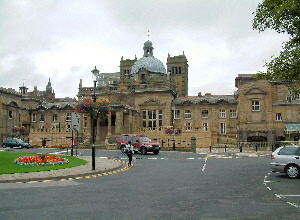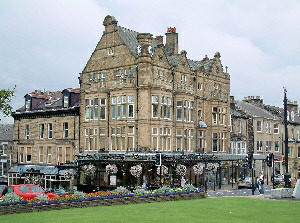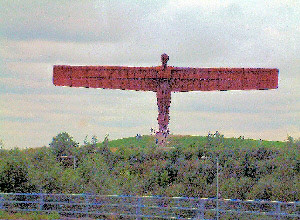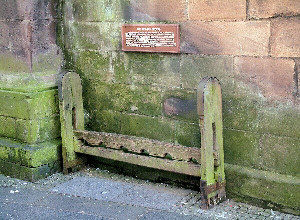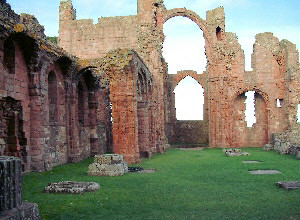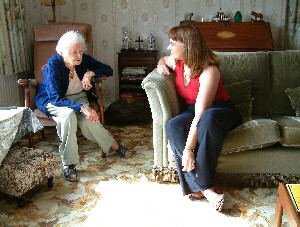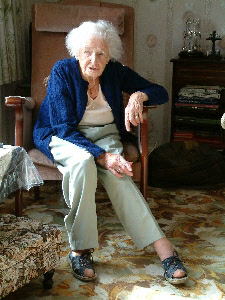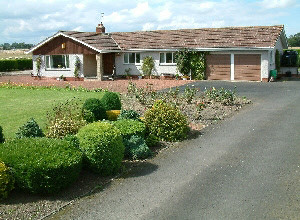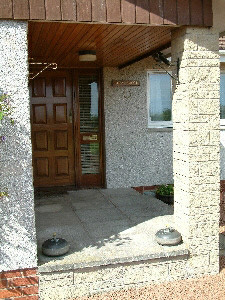15 April 2001
Dear Mum and Dad
I have received my latest Marathon Update magazine and with it the registration card. Someone has to go to the London Arena near Greenwich and get me registered because I’m not allowed the time off work. Elaine has volunteered to go because she will still be on holiday that day. With registration comes a gear bag, my running number and a big sticker with my running number on it that has to go onto the gear bag. There is also the ChampionChip that I have to wear on the day of the race. No number and you can’t run, no chip and you won’t get a time. You wear the chip on your shoe, and relace it to take the chip.
The gear bag gets taken away just before the race starts, and they will only accept the official LM gear bag. You pick it up after the race and hopefully it will still have your warm clothes in it. I’ll put in Elaine’s cellphone, too. If it gets pinched, too bad we can always get her a new one. Elaine will have mine because that phone has better reception in London and its number is the one all my agents ring me on and it’s cost me an awful lot of money to get that number known. I have photocopied the relevant pages from my Runner’s World mag and from the Marathon Update. I’ll ask Elaine to go on the Wed so if there is anything missing, she will have time for a return visit. We looked at the railway timetables yesterday and found out that if we catch the Thameslink train to Brighton, get off at London Bridge and catch the Connex South train to Blackheath, I will be there on Sunday morning around 8:00am ready for a 9:30am start.
The marathon starts on Shooters Hill Rd in Greenwich Park and ends in The Mall, outside Buckingham Palace. At about the 6-mile mark we go past the Cutty Sark, cross Tower Bridge just before the half-way point, run past the Thames Flood Barrier at about the 30km mark, then along The Embankment to Birdcage Walk, with St James’ Park on our right, swing past the Victoria Monument outside Buckingham Palace and finish a couple of hundred yards up The Mall.
There is an area in Horse Guards Road where they have put up A-Z letters on poles. You arrange to meet under the letter that corresponds with your family name. Good idea. But the best news is that I have a BLUE start. Only the elite and serious runners get to go from the blue start. The green start is for the not serious and the red start is for the Football Challenge, the fancy dress runners and other team and fun events. I can only guess that from my entry form where I said that my best time was the Petersfield 1/2 Marathon at 1:38:12, and was aiming for a 3:30:00 time, someone must have deduced that this was my first marathon and I wasn’t mucking about.
After having watched me start, Elaine can walk through the Greenwich tunnel under the Thames and see me pass the 6 mile mark, then walk about 1/2 mile further along and see me pass the 20-mile mark. We’re still trying to work out how she gets to Buck House to meet me at the finish, but it looks most likely that the Docklands Light Railway will be able to deliver her very close to The Mall.
The weekend before last we took a trip to Birmingham so I could to run a 22-miler with the Runner’s World magazine pacing team and that was quite interesting. I rang the Sutton Court Quality Inn hotel to make sure the park was still open, and they said it was. I thought that was a bit unusual because there should be deer in the park somewhere and the Lake District, where the heaviest concentration of foot and mouth disease cases is to be found, isn’t very far away. However, the park was open, and in spite of the rain on Saturday afternoon it looked very pretty.
I looked up the postcode for the Sutton Court hotel on multimap.co.uk and printed the maps to get there. We followed the maps carefully and then, when the landmarks looked right I said, “It should be here, on your right.” And there it was! A Victorian building, with creaky oak stairs, tarted up with modern signs. We thought it would take about 3 hours to get there, but going up the M6 was very smooth and we were there in around 2 hours. The locals call themselves Brummies.
Sutton Park is huge – 2400 acres – and it was easy to devise a 22mile run there. A while ago it was used for a leg of the International Motor Rally. There’s a forest in there of a 750 acre stand of oak trees. The town itself is called The Royal Town of Sutton Coldfield and Sutton Park was a hunting ground of Henry V111, that man again. He was there with Bishop Veysey in 1528 when he was charged by a boar, but before it hit him the boar was felled by someone’s arrow. Henry looked around for the huntsman and a rather attractive young woman came up to him, bow in hand and it was she who had killed the pig.
In gratitude, Henry gave her family some land and gave her village the Tudor Rose to use as its emblem. The town charter for Sutton Coldfield was given to the town in 1528 by Henry himself and you can see the Tudor Rose on many of the civic works and, of course, in the town’s coat of arms. There’s not much of the old village left, apart from a few Tudor buildings in the main street but there are lots of very nice Victorian buildings and evidence of an enormous amount of 1930s and 1950s building.
Running with the paced group in Sutton Park has highlighted the need for much better organization on my part. I didn’t organize my Saturday well enough and I didn’t organize my breakfast and drinks well enough for the Sunday run. Unfortunately, there were only 2 drink stops, one at 10.5 miles and the next at 20 miles. We were told at the beginning that the laps were 7.5 miles each, so I was not prepared for such big laps with so little water.
As a result, the last 1.5 miles I spent almost walking. It was so humiliating. If it had been the marathon, I’d have been 5 miles short and looking at taking at least another hour to finish. The time for the run was 3:15:00hr and I finished in 3:17:00hr, so that’s not too bad, but it has woken me up to the perils in store. Physically I think I’m ready but I suppose because of the lack of race experience, made worse by all the races I have entered being cancelled, I do not have a good organization worked out for race days. I’m very pleased I went and got such a knock to waken me up – it would be truly horrible to put in so much effort and then have it all ruined because I ran out of energy 4 miles from the end. Proper organization for London should get me to the finish on time.
For a while, I ran with a small group that included a young woman who said she’d run London before and this time, to raise funds for her charity, she was making pizzas. I told her I was running London as my first ever marathon and she said, “You’ll enjoy it so much, the atmosphere is huge. There are bands playing and groups singing and people all along the track; you’ll love it. Don’t try too hard for your time because London is to be enjoyed rather than raced.” She said she had run it several times but that running the London Marathon was still the most important thing she had ever done in her life. “At the end of my life,” she said, “I don’t care what they do to me, but I want to be buried with my London Marathon medals.” How cool.
I wish someone would make some decent socks! All of the socks I have worn so far have got raised seams and most even have knots. The 1000 Mile socks were no good, either. The only ones that are ok-ish are new Nike terry socks. As soon as they are washed, they are too stiff and scratchy to run in for a long distance. All the rest are too scratchy anyway. I couldn’t find any Thorlos socks, but I’ll try them next. The main thing I have missed out on in the build-up to the LM has been racing. I have had so many races cancelled on me. I realised last weekend that if I’d had more races, I’d have been better prepared for the event. My organisation would have been better. So fun runs and races are good. Fun runs, where no-one expects or wants you to race, will be good out-and-about stuff and won’t harm training.
At races you meet people who are different from people you have ever met before. Elaine and I have been very pleasantly surprised at the friendliness and quality of the people we have met. I think the reason for their extra qualities is their willingness and ability to concentrate on a task and organize themselves to achieve a goal they have set themselves. It’s quite interesting. If you are a member of a team, you help the whole team achieve its goal(s), but usually those goals are set for you. As a runner, you set your own goals and only you care whether or not you achieve them; most of the time, also, you are the only one who knows.
Thank you very much for your letter explaining your situation. The last time I spoke to you, you thought you would be out of the house within a month and you have lasted two months. Well done. I couldn’t see how you were going to get through the winter lugging all the wood in and keeping things going while you were so obviously not very fit. Elaine and I are very impressed with the huge amount of work you have done and the responsibility you have shouldered in sorting out your affairs and taking care of all your property. Sheryll has emailed me to say that you have given Bryan all the photos and correspondence to look after until I collect them. She and Bryan are quite happy to look after that material and I will pick it up in due course, or arrange for Joni to collect it. Rest assured it will be well looked after.
I have spent a most interesting weekend reading all that material that Janette Stallman and Jim Spence sent me. When I read it first I saw it only through the fog that was left of my brain after Jason’s death and I got all sorts of facts wrong. This weekend has been most enlightening. Mum’s parents were born in NZ, but her father’s parents were all from Ireland while her mother’s parents were English. Janette Stallman’s father, Robert, was my grandfather James Ewart Dawson’s (Mum’s dad, Lofty) brother. He would have been Uncle Bob to Mum. Did she know him?
That makes me and Jeanette second cousins, though I have never met her. The Dawsons have been in Lisburn, just outside Belfast in what is now N Ireland, since at least 1776. They were Presbyterian. It’s interesting to speculate whether they considered themselves Irish or British, isn’t it, in the light of the division of Ireland. Anyway, if we skip to 1852, that was when Richard Dawson’s son, William (1821-1889) married Ann Ewart, in Lisburn.
They had 9 children; one, William, was to be Lofty’s father, and another, James Ewart Dawson (1860-?) is of interest to me. Lofty’s father, William (1857-1910) served in the Royal Irish Constabulary in Sligo, Eire, until he was dismissed in 1881 and soon thereafter he emigrated to NZ. Janette Stallman says that the Dawson name is Scottish and the Dawsons would have gone to Belfast from Scotland, a distance you can almost row, to work in the plantations.
She says that Ewart is a Saxon word to do with sheep-herding, so that the Ewarts probably have an English ancestry, but from where is unknown. Ann Ewart (1826-1898) was the daughter of John Ewart and Jane Kirk, also of Lisburn, married in 1809. She names her fourth son, James Ewart Dawson. Now, Mum’s grandfather, William goes to NZ in a ship called Crusader, in 1882. My bet is he went from Belfast to Christchurch. 8 Years after he arrives he marries Margeurite Matthews. Married in The Manse, Leeston, Canterbury, 12 April 1889. Look at that name, Margeurite. Mum’s grandmother.
The Matthews come from the other side of what is now N Ireland. Remember the Omagh bombing? The Matthews come from near there, in County Tyrone; a place called Lisnacloon, 11 miles south-west of Strabane. They were a farming family, paying rent on properties which were let to them “for life.” Margeurite’s parents were Matilda Kinnear and John Matthews. Matilda’s father was David Kinnear, born in the 1790’s. So they have been in the area for a while, haven’t they? And it clears up the mystery of Mum’s two names. There is another very interesting point, though, and that is that John Matthews’ older brother, James, married a girl called Marianne KYLE, in 1827. John and Matilda are married in the 1840’s so Matilda would have known the Kyles well.
Now, when she gets married in NZ, look what Margeurite does:
- A daughter, Matilda
- A son, James Ewart
- A son, Thomas Edwin Kyle (whom Mum called Uncle Kyle)
Isn’t that interesting! And Lofty, in his turn, called his only daughter Margeurite Matilda. He probably called Mum Matilda after his sister, Tilly, who died at only 36yrs, of TB, but you can see where the name came from – Matilda Kinnear of Linsacloon.
And then I had a look at Mum’s mum and I got an awful shock. Elsie’s parents were English. Not only that, but they lived not far from here! Elsie’s father was Albert Edward Orange (1865-1942) and he was born in Glen Parva, Leicester. He came to NZ in 1878, via Garonne in France and Melbourne. Now Leicester, as you will know from a few of my earlier letters, is about 2 hours up the M1 from here and we go there to see Elaine’s cousin Jack Dalgliesh and family. So Leicester isn’t exactly unknown to us.
There are several Glen … places to the south of Leicester city and just in the crook of the M1 where you turn onto the outer ring road is Glen Parva. Next time we go to Leicester, we’ll have a little wander and see what’s still standing from the 1870’s. All of that would have been familiar to Albert.
When he got to NZ, Albert married Helen Hinkley (1888-1928, div 1924.) She had come out to NZ in 1883 and was the daughter of John Hinkley and Susan Henderson. She was born at home, 53 Union St, Southwark. That place name rang all sorts of bells and I found it on a street map of London. Union St, Southwark is about ½ a mile from Blackfriars. It’s on the south of the Thames, you just cross Blackfriars Bridge and keep going south until you get to Union St. Simple. We are going to go there to see what remains of 1860’s London. There could be a lot, there could be a little. But it will be interesting.
Frank’s mum (Sadie) came from Wing in Buckinghamshire and his grandfather, Levi, came from Stanbridge in Bedfordshire, six miles away, on the other side of Leighton Buzzard. I have
walked from Leighton Buzzard to Wing and it’s not very far. Levi and his new wife, Sarah, shifted to Wing very soon after they were married and their first son, Arthur, was born in Wing but baptised in Stanbridge. I found out recently that you can’t baptise your children, nor be buried, in just any church. Levi’s mother was still in Stanbridge and he went there often all through her life to see her.
Because of where he had been born, brought up, got married and only just left, he was required to go back to Stanbridge to have Arthur baptised. As I said, it’s not a very long trip from Wing to Stanbridge. Arthur grew up in Wing, where Levi built a very prosperous blacksmithing business. Sadie’s parents were killed in unusual and tragic circumstances and her brothers were sent to an orphanage where they were very badly treated while Sadie grew up with her maternal grandmother, Catherine Scarlett, in deep poverty in the almshouses in Wing.
She and Arthur courted while working for the Rothschilds in Ascot House, Wing. Dad’s brother, Fred was born in London and Sadie and Arthur emigrated to NZ in 1911. Dad was born in Hastings in NZ in 1915 and his father died the same year, aged just 40. If Dad had been born in London instead of Hastings, I’d have a right to a British passport the same as Fred’s kids do. They don’t want it.
The most interesting thing to me is that almost every Tearle in the world is from the same family. Unfortunately, there are now a few people whose first name is Tearle, but it just migrated there, like my name is Ewart and that’s my Irish great-grandmother’s maiden name, hence it was my grandfather’s middle name. Mum wanted to call me after her father, but she didn’t want to call me Jim, so I got his middle name. Bryan was called Bryan because Mum liked the name, Theodore after Dad (but I’ve never found out who the original Theodore was) and Richard after Mum’s brother.
I had a very interesting night late last year when Ivor Adams, Donn Heath and I all met for the second time. We were discussing our respective grandparents. Mine is Sadie, Ivor’s was Joe, Sadie’s brother and Donn’s was Fred, Sadie’s other brother. When they got it clear, both Ivor and Donn sort of stopped and looked me. Their relationship to their Adams grandparent was exactly the same as mine. They thought I was a foreigner and in the end, it’s just my accent. It was a fascinating moment – even though I had lived with Ivor for over 6 months and he knew what my relationship with Sadie was. It sometimes takes more than just saying something actually to make real sense of it.
My contract at Tesco is on its last legs but may go until the end of June. So it looks like I am about to find a new adventure. It’s been very nice working there and it has been very good having a steady income for such a long time, that has certainly helped us to stay here AND we got home for Christmas AND we got Elaine a nice little car AND we paid our taxes, both in NZ and in Britain. All of that doesn’t help us to save very much, but at least we are still here, we have a nice little flat and we are still debt free.
Oh, yes! I got an award. It’s called the Tesco Values Award – for living the Tesco values, you see. “No-one does better for customers,” and “Treat others as you want to be treated.” It seems that a whole department nominated me. It came right out of the blue and is relatively rare. I was quite chuffed, still am.
It was very sad to convey to you the bad news about Clarice. She was a lovely lady and when we needed her, she was there. She and Thelma and Sheila came all the way to NZ to be with us in the year Jason was killed. I spoke to Thelma about it last night and it was one of the great adventures of her life. Thelma and Clarice had always been close, but their trip to NZ was a special bond. It depends on when the funeral is, but we’ll try our best to go and we’ll go and see Keith and Jill soon anyway. Let’s hope they like Ilfracombe, because they have only just shifted there – they moved farm, stock and everything to be closer to Clarice. We have bought a card to send from us, but we have also bought a card to send for you and Mum. I know it will be deeply appreciated and it was a privilege to be asked to send it for you. It’s also a lovely card. The English make beautiful, thoughtful and memorable cards.
Outside at the moment the weather is doing its best to imitate the blasted heath in King Lear because the wind is noisy, the rain is being whipped along and the sky is a deep and heavy grey. However, the cheeky daffodils are nodding and if they are not overly bothered, why should I be concerned? And I have the funniest news. You know there is quite a decent sized pond outside our flat; it’s kidney shaped and about 30m x 10m with trees planted closely around its banks but heavily overgrown with raupo. There’s a lot more reeds than water.
About three weekends ago, I noticed a lot of fish jumping about near the bank closest to our flat so I went over to see what was going on. It wasn’t fish, the disturbance was being caused by dozens of spawning, brown froggy things. I contacted the University of Hertfordshire by email with a message to Christine Shepperson, in which I asked her to pass on my worries about whether the creatures were frogs or some nasty little noxious toads. If they were the latter, I reckoned that someone who knew these things would have a very good opportunity to clear out lots of toads.
Christine said that she would pass on the message about the frogs/toads but would I like to keep an eye on the pond and let her know when the dragonfiles were flying. So I said I’d keep a lookout. Next thing I get in the mail is my membership of the Hertfordshire Dragonfly Group … unbelievable. Their bi-annual newsletter is theBrachytron and I am the proud owner of issue only number 3.
My job for the rest of my sad life is to haunt the ponds of Hertfordshire, beginning with our little Milford Close pond, on the lookout for Small Red-eyed Damselfiles, Azure Damselflies, Blue-tailed Damselfiles and the Large Red Damselflies. Keep a sharp lookout for the Brown Hawker and the Norfolk Hawker, both true dragonflies. Elaine says if I go out on a Sunday afternoon, with flask, binocculars and hamper at hand wandering the countryside looking for dragonflies then she’ll know that I will finally have totally flipped and there’s no further hope for me.
But I suppose that means that you can send a search party to retrieve me should I ever write to you in great excitement that I have found only the second breeding site known in Britain of the Lesser Crinkle-back Banded Demoiselle. The dragonfly enthusiasts are migrated bird-watchers. I’ll keep an eye on the pond because Christine asked me, but don’t worry I won’t be wandering through the copses looking for mating dragonflies. The toads, by the way, turn out to be common English brown frogs and perfectly respectable to have as neighbours. At the moment their frenzied efforts of a few weekends ago have become thousands of tiny, black, wriggling tadpoles. Good luck to them. May the herons be blind.
Keep well, won’t you.
Lots of love
Ewart and Elaine.



